
Roots
The very air we breathe, the spaces we inhabit, and the materials that touch our skin and strands all participate in a silent, continuous dialogue with our hair. This conversation, often overlooked in its subtle yet profound impact, shapes the vitality of our curls, coils, and waves. When considering the delicate balance of moisture and protein within textured hair, one might not immediately turn to the fabric resting against it each night or the cloth used to absorb excess water.
Yet, these seemingly simple choices hold significant sway over the hair’s inherent resilience and luster. Understanding this relationship begins at the foundational level, with the hair’s intrinsic architecture and its interaction with its immediate environment.

Hair’s Unique Construction
Each strand of hair, a marvel of biological design, possesses a complex construction tailored to its function. At its core lies the Medulla, a soft, central channel, though not all hair types exhibit a medulla. Surrounding this is the Cortex, the hair’s primary structural component, composed of keratin proteins. This cortex provides hair with its strength, elasticity, and pigment.
The outermost layer, the Cuticle, consists of overlapping, scale-like cells, much like shingles on a roof. These scales, when healthy, lie flat, reflecting light and offering a smooth surface that reduces friction between individual strands and external elements. The cuticle serves as the hair’s first line of defense, guarding the delicate inner cortex from environmental stressors and mechanical damage. The integrity of these cuticular scales directly influences how well hair retains moisture and how resistant it is to external forces.
For textured hair, this architecture presents particular considerations. The elliptical or flattened cross-sectional shape of curly and coily strands means the cuticle scales do not lie as flat as on straight hair. This natural lift creates more opportunities for external forces to interact with the cuticle, potentially causing it to lift further, leading to increased friction and moisture loss. The natural bends and twists also serve as points of vulnerability, where the hair shaft is structurally weaker and more prone to breakage when subjected to mechanical stress.

Moisture and Protein Balance
Hair health relies upon a delicate equilibrium between moisture and protein. Moisture, primarily water, provides pliability, softness, and helps maintain the hair’s natural curl pattern. It is absorbed into the cortex, plumping the hair fiber and making it less brittle. A lack of sufficient moisture results in dryness, stiffness, and increased susceptibility to breakage.
Proteins, predominantly keratin, give hair its structural integrity and strength. They form the very building blocks of the hair shaft. When hair experiences protein loss, it becomes weak, limp, and loses its ability to hold a style. Maintaining this balance is a continuous effort, influenced by internal factors like diet and genetics, and external factors such as environmental humidity and, notably, the fabrics that touch our hair.
The fundamental architecture of hair, particularly the cuticle, plays a significant role in how well it maintains its internal moisture and protein balance when interacting with various materials.

Understanding Hair’s Interaction with Surfaces
The surface of hair, particularly the cuticle, is covered by a covalently bound monolayer of a unique branched fatty acid, 18-methyleicosanoic acid (18-MEA). This layer provides a hydrophobic surface and acts as a boundary lubricant, reducing friction between hair fibers. When this protective layer is compromised, the hair surface becomes more hydrophilic, and friction increases. This heightened friction is a key player in the mechanical damage hair experiences.
Consider the simple act of resting one’s head on a pillow or drying hair with a towel. The texture and absorbency of the fabric directly influence the amount of friction and moisture transfer that occurs. Rougher surfaces, with their irregular fibers, create more friction against the raised cuticle scales of textured hair.
This mechanical abrasion can lift, chip, or even break these scales, leaving the inner cortex exposed and vulnerable to moisture evaporation and protein degradation. Conversely, smoother surfaces allow hair to glide, minimizing physical stress.
The interplay of hair’s surface chemistry and the physical properties of textiles dictates much of its daily well-being.
| Hair Component Cuticle |
| Primary Function Protective outer layer, regulates moisture |
| Vulnerability to Fabric Mechanical abrasion, lifting of scales, loss of 18-MEA |
| Hair Component Cortex |
| Primary Function Strength, elasticity, pigment |
| Vulnerability to Fabric Moisture loss, protein degradation (if cuticle is compromised) |
| Hair Component 18-MEA Layer |
| Primary Function Hydrophobicity, friction reduction |
| Vulnerability to Fabric Removal by alkaline treatments, mechanical rubbing |

Classification Systems and Their Relevance
While a precise classification system for textured hair helps in product selection and styling, it also offers insights into inherent vulnerabilities to external factors. Hair types, often categorized by curl pattern (e.g. 3A, 4C), correlate with the hair shaft’s shape and the degree of cuticle lift. For instance, tightly coiled hair (e.g.
4C) typically possesses a more elliptical cross-section and more exposed cuticle edges, making it inherently more prone to tangling and breakage from friction than looser waves. This predisposition means fabric choices become even more significant for these hair types. Acknowledging these differences allows for more informed and gentle care practices, tailored to the unique needs of each hair pattern.
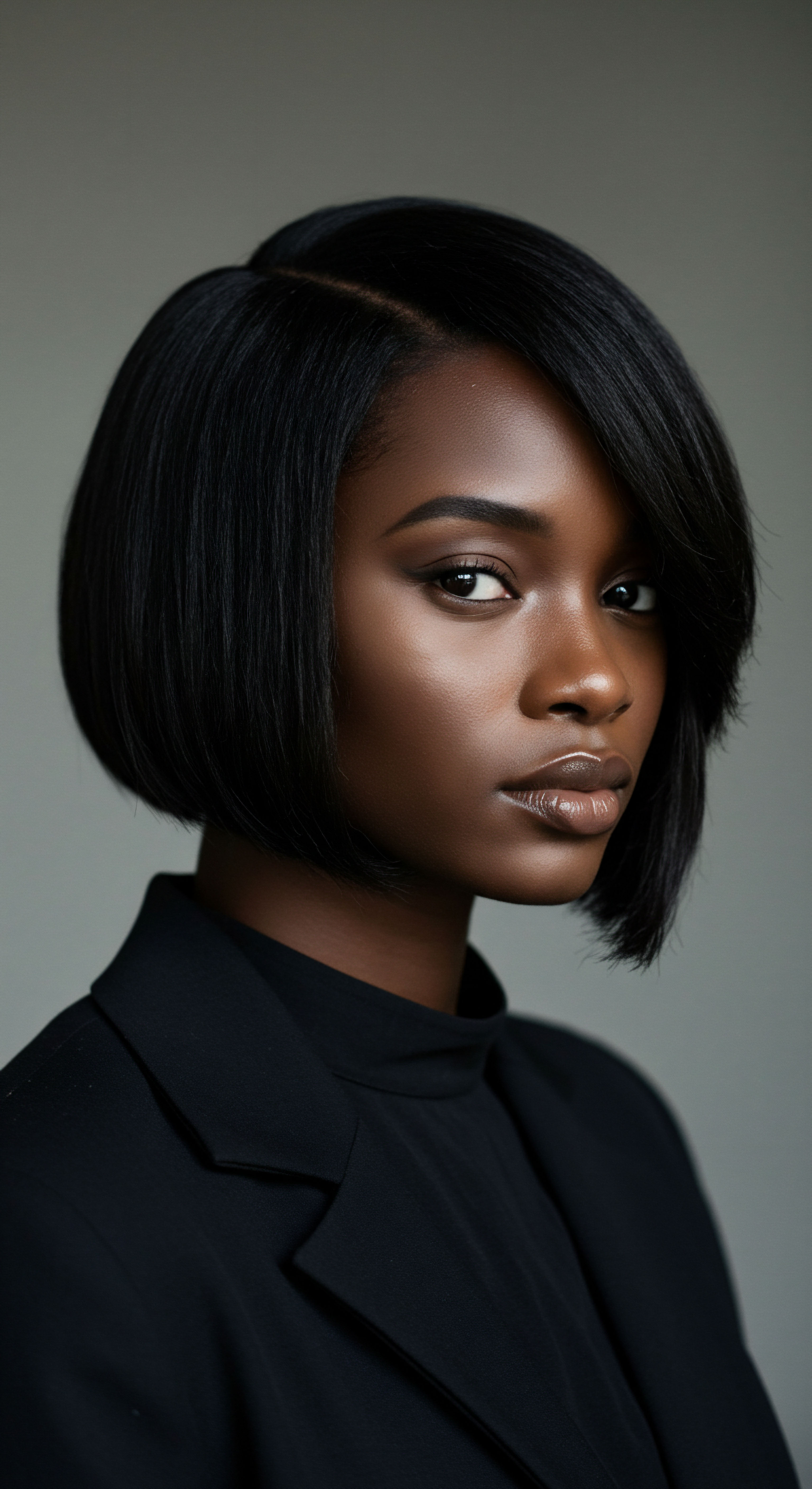
Ritual
The journey of hair care, for many, extends beyond the mere application of products; it settles into a rhythm of daily and nightly practices, each step a gentle conversation with our strands. This section seeks to illuminate how the seemingly mundane choices of fabric, woven into these routines, truly shape the hair’s enduring health. We move from the hair’s fundamental nature to the applied wisdom of its care, exploring how thoughtful selection of textiles can serve as a silent guardian for moisture and protein.
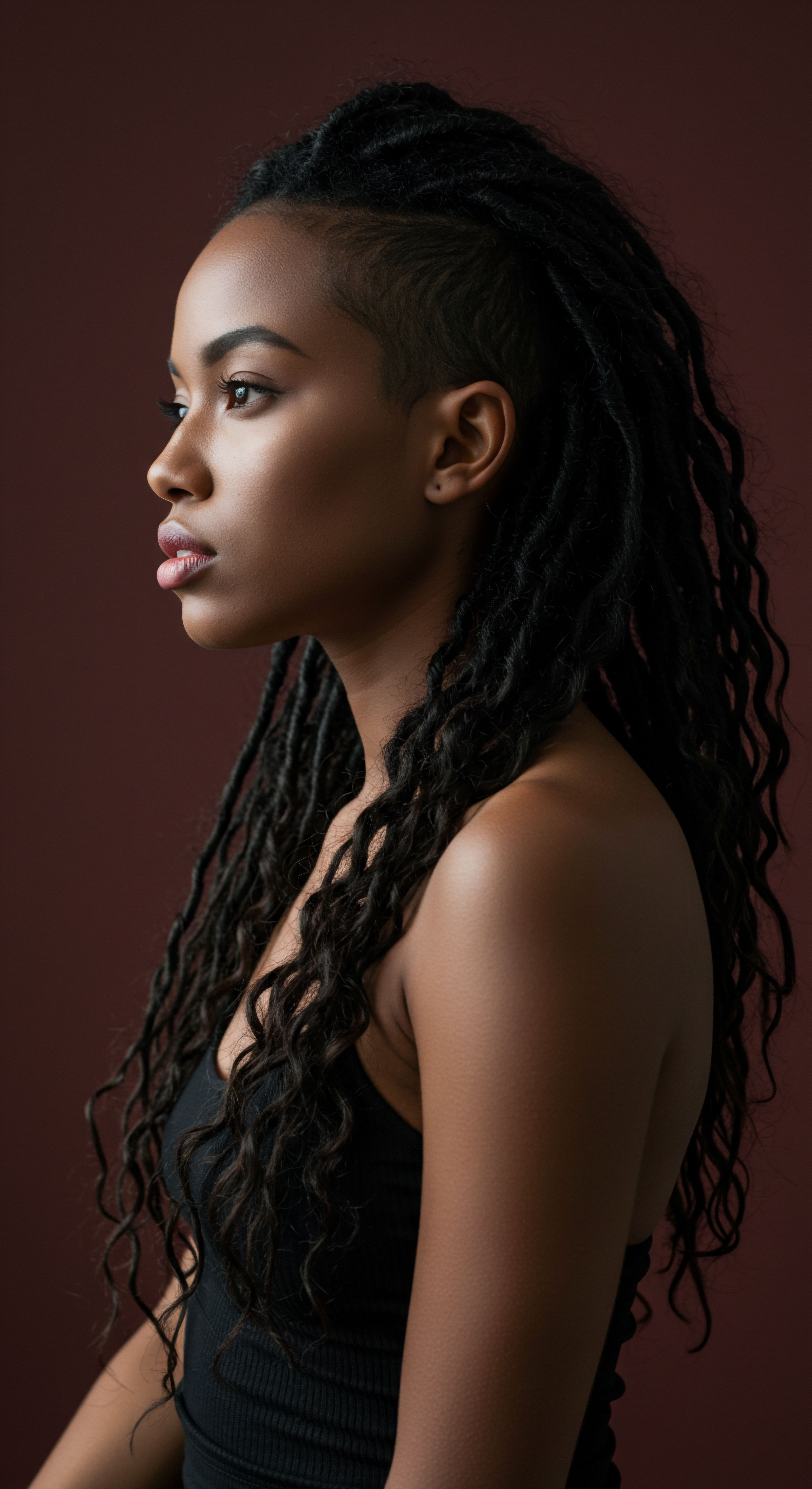
The Daily Contact of Fabrics
From the moment we rise, our hair begins its interaction with various textiles. The pillowcase where we rest our heads, the towel used post-wash, the headscarf donned for protection or style, and even the clothes we wear all play a part. Each interaction carries the potential for either gentle protection or subtle attrition. The surface texture of these materials, their absorbency, and their ability to generate static electricity all contribute to the cumulative effect on hair.
A primary concern with many common fabrics, such as cotton, lies in their absorbent nature and rough surface. Cotton fibers, being hydrophilic, readily absorb water. While this property is desirable for drying skin, it can draw precious moisture directly from hair strands. Imagine a thirsty sponge; cotton acts similarly, pulling hydration from the hair, leaving it dry and brittle.
This effect is particularly pronounced in textured hair, which naturally tends towards dryness due to its structural characteristics. Furthermore, the microscopic unevenness of cotton fibers creates friction against the hair’s cuticle. This friction can lift and disrupt the cuticle scales, leading to frizz, tangling, and ultimately, mechanical damage and protein loss.
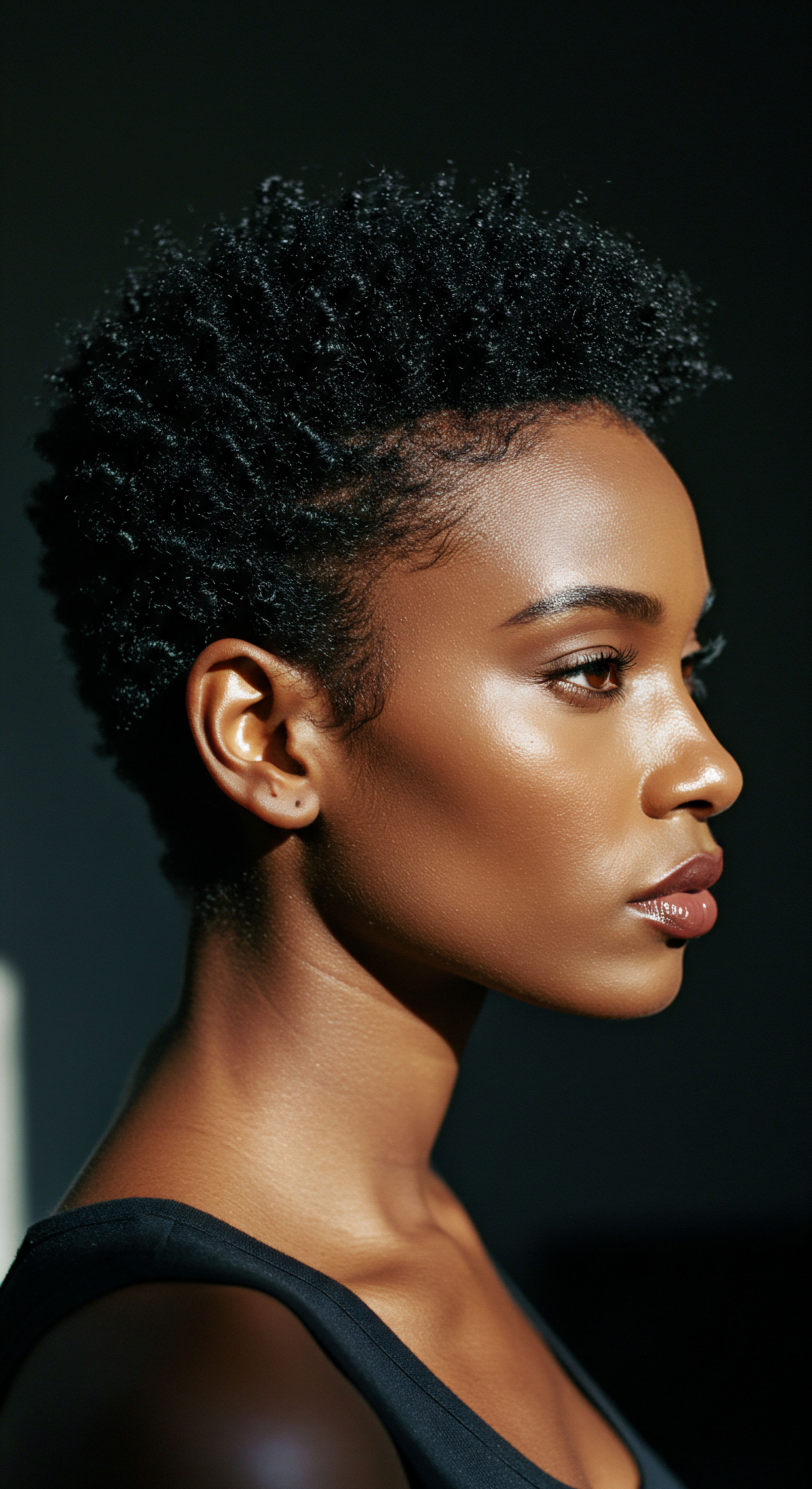
Selecting Hair Friendly Textiles
A mindful approach to fabric selection can significantly mitigate these adverse effects. The alternative materials, primarily silk and satin, offer a smoother surface and reduced absorbency, presenting a kinder environment for hair.
- Silk ❉ Derived from natural protein fibers, silk possesses a smooth, tightly woven surface that minimizes friction against hair. This reduced friction helps to keep the hair’s cuticle layers flat, thereby preserving moisture and reducing mechanical damage. Silk is also less absorbent than cotton, meaning it does not draw hydration from hair in the same way. Its natural protein composition also lends a gentle affinity with hair’s own protein structure.
- Satin ❉ While often confused with silk, satin refers to a type of weave, not a fiber. Satin can be made from various fibers, including polyester, rayon, or silk. When made from synthetic fibers, it offers a smooth surface similar to silk, providing comparable benefits in terms of reduced friction and moisture retention. While synthetic satin does not possess the natural protein benefits of silk, its smooth surface is still highly beneficial for hair health.
Consider this comparison of material properties:
| Fabric Type Cotton |
| Surface Texture Rough, fibrous |
| Moisture Absorbency High |
| Hair Friction High |
| Fabric Type Silk |
| Surface Texture Smooth, natural protein |
| Moisture Absorbency Low |
| Hair Friction Low |
| Fabric Type Satin (Synthetic) |
| Surface Texture Smooth (weave) |
| Moisture Absorbency Low to Moderate |
| Hair Friction Low |
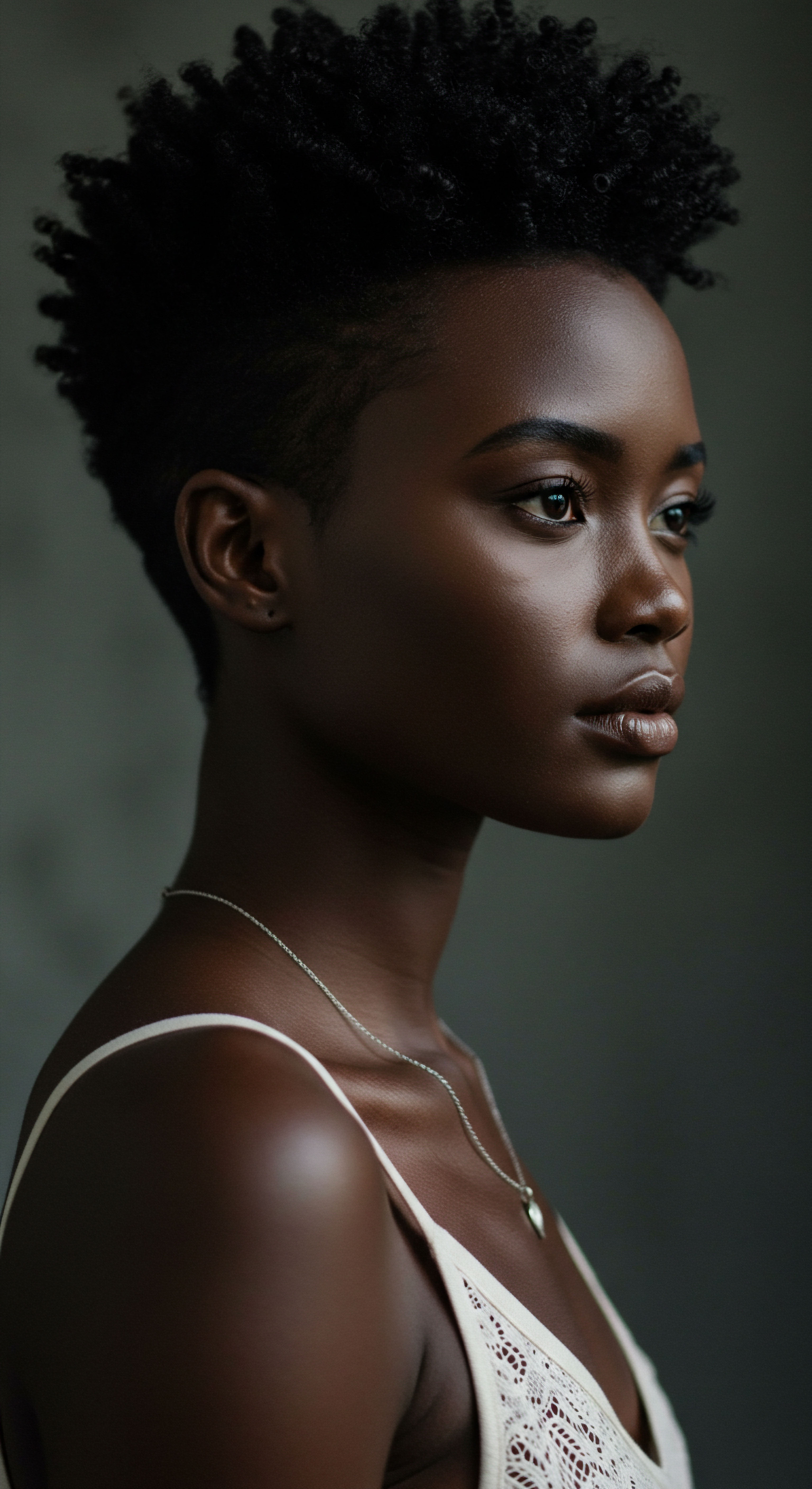
Hair Drying Practices and Fabric Choice
The way we dry our hair immediately after washing can have a lasting impact on its integrity. Vigorously rubbing wet hair with a standard terry cloth towel, typically made of cotton, is a common practice that can inflict significant damage. Wet hair is particularly vulnerable because the hair shaft swells, and the cuticle scales are more pliable and prone to lifting. The rough fibers of a cotton towel, combined with aggressive rubbing, exacerbate cuticle damage, leading to frizz, breakage, and moisture loss.
A more gentle approach involves using a microfiber towel or an old cotton t-shirt. Microfiber towels are designed with smaller, smoother fibers that absorb water efficiently without creating excessive friction. Similarly, the smooth, flat surface of a cotton t-shirt provides a softer alternative to terry cloth. Instead of rubbing, gently squeezing or blotting the hair with these materials helps to remove excess water while preserving the cuticle’s integrity.
A study on hair keratin integrity under different drying conditions found that hair dried with a microfiber towel showed better wear resistance compared to hair dried with a cotton towel or a blow-drier. This highlights the importance of fabric choice even in the initial stages of hair care.
Conscious fabric choices, particularly for pillowcases and drying cloths, form a silent yet powerful part of preserving hair’s inherent moisture and protein structure.
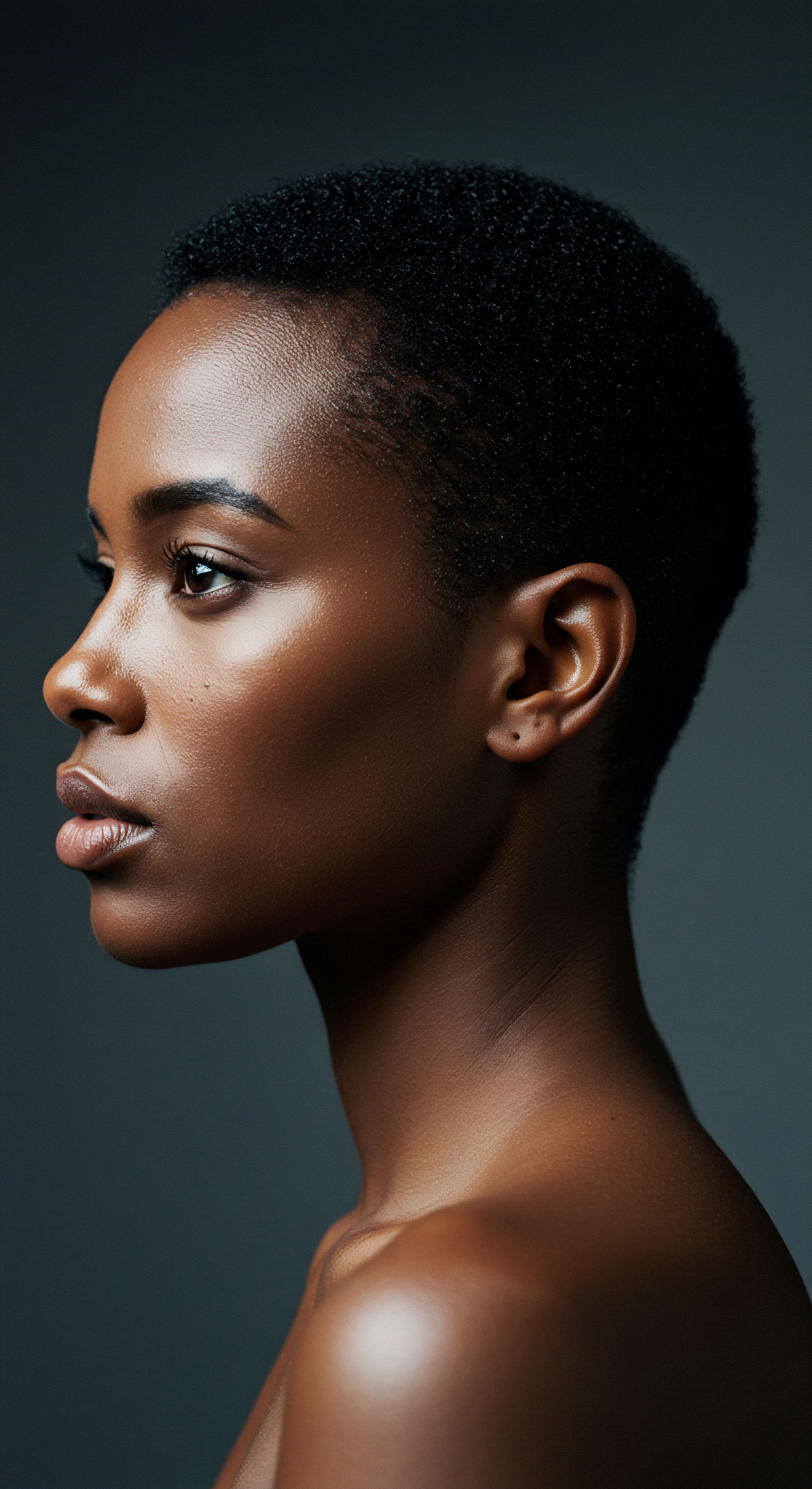
Protective Styling and Fabric Companions
Protective styles, designed to shield delicate ends and minimize manipulation, are a cornerstone of textured hair care. The fabrics used in conjunction with these styles, such as bonnets, scarves, and durags, are equally important. These accessories create a protective barrier between the hair and external elements, including abrasive fabrics found in bedding or clothing.
Opting for versions made from silk or satin for nighttime protection ensures that the benefits of protective styling are not undone by friction during sleep. These materials allow hair to glide freely, preventing tangles, breakage, and the absorption of natural oils and applied moisture.
Even during the day, head coverings chosen for cultural expression or practical needs can contribute to hair health. A vibrant headwrap, if made from a smooth, non-absorbent material, can shield hair from environmental aggressors like wind and sun, which can strip moisture and cause dryness. This practice connects the wisdom of ancestral traditions, where head coverings were both adornment and protection, with modern scientific understanding of fiber interaction.
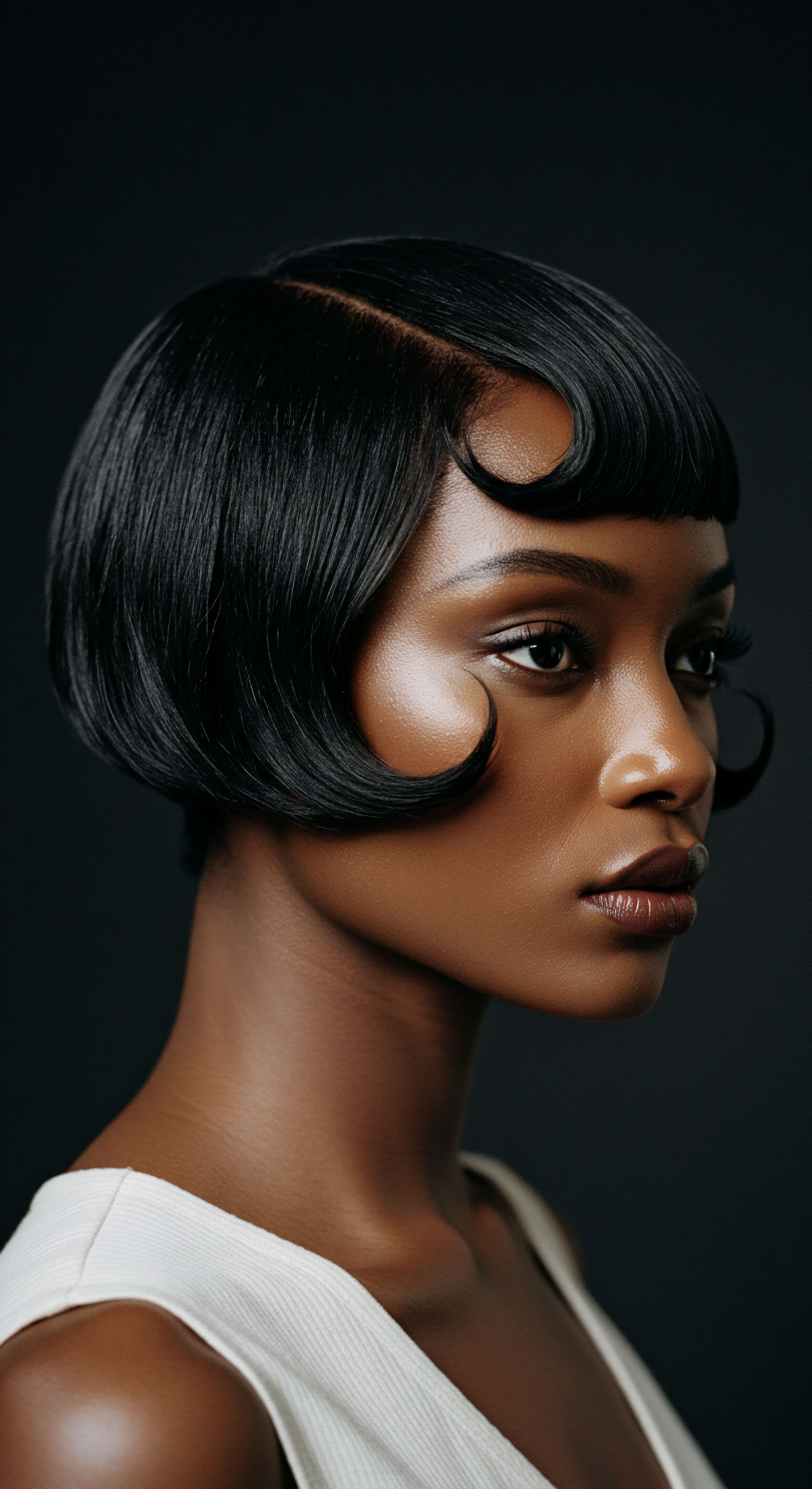
Relay
Stepping beyond the daily rhythms, we confront the deeper interplay of science, history, and cultural practice in shaping hair’s vitality. The subtle yet relentless forces exerted by our textile companions extend their influence far beneath the surface, touching the very protein bonds that give hair its strength and the delicate moisture balance that defines its resilience. This exploration requires a closer look at the mechanisms of interaction and the long-term consequences of seemingly minor choices.

Microscopic Effects of Fabric on Hair
At a microscopic level, the hair’s outermost layer, the cuticle, is a sophisticated defense system. It consists of overlapping scales that lie flat when healthy, forming a smooth, protective barrier. However, this barrier is susceptible to mechanical abrasion. When hair rubs against rough surfaces, such as cotton, the irregular fibers of the textile catch on these delicate scales, causing them to lift, chip, or even break.
This process, often invisible to the naked eye, is a primary contributor to frizz, dullness, and ultimately, breakage. The greater the coefficient of friction between hair and a surface, the more pronounced this damage becomes.
A study investigating the friction dynamics of different hair types against various surfaces found that African hair exhibits a higher friction coefficient compared to Asian hair when sliding against certain textiles like polyester. While the study noted lower friction for Asian hair against polyester, it also highlighted that cotton generally proposed the highest friction coefficient, especially at lower loads, regardless of hair type. This differential friction effect, where hair experiences greater resistance when rubbed against certain materials, underscores why fabric choice holds such significance for textured hair, which already possesses a naturally raised cuticle structure. This heightened friction not only damages the cuticle but also compromises the hair’s protective 18-MEA layer, making the hair surface more hydrophilic and further increasing friction.

Moisture Dynamics and Fabric Absorbency
Hair’s natural moisture is held within its cortex, shielded by the cuticle. Fabrics, particularly those with high absorbency, can disrupt this delicate balance. Cotton, being highly hydrophilic, acts as a wick, drawing water from the hair shaft. This osmotic pull can lead to significant dehydration, leaving hair dry, brittle, and more susceptible to mechanical stress.
The effect is akin to leaving a sponge on a damp surface; the sponge will continuously pull moisture until equilibrium is reached. For hair, this means a constant battle against moisture loss, especially during prolonged contact, such as overnight sleep.
Beyond simple absorption, the breathability of a fabric also plays a role. While tightly woven, non-breathable fabrics might trap some moisture, they can also create an environment that encourages microbial growth or prevents proper air circulation, potentially leading to scalp issues that indirectly affect hair health. The ideal fabric allows for some air exchange while minimizing moisture transfer from the hair itself.
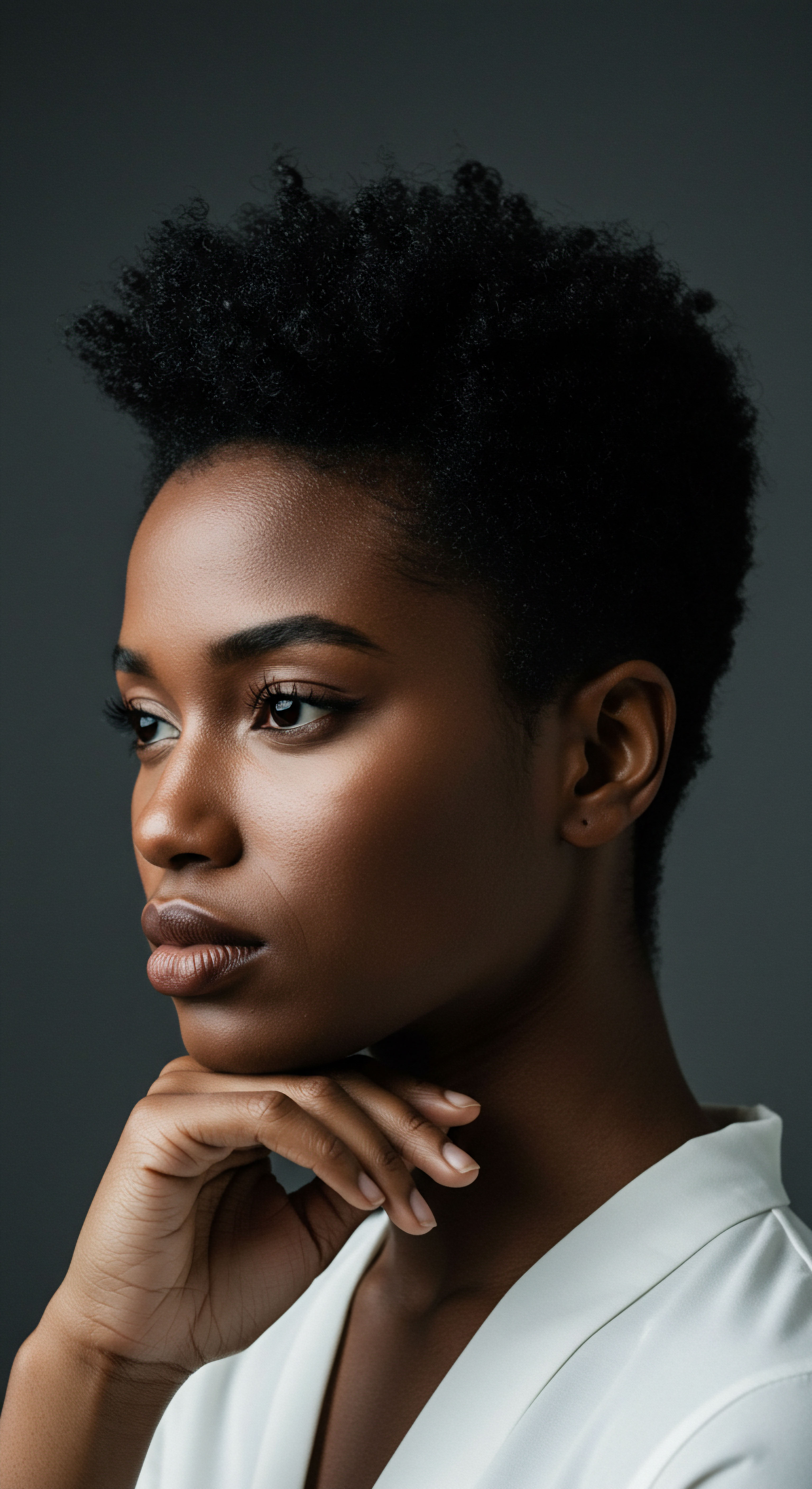
Protein Integrity and Mechanical Stress
The core strength and elasticity of hair come from its protein structure, primarily keratin. When the cuticle is compromised by repeated friction, the underlying cortex becomes exposed. This exposure makes the keratin proteins vulnerable to degradation.
Mechanical stress, such as that from rough fabrics, can lead to the physical removal of protein from the hair shaft. While chemical treatments like dyeing and straightening are known to cause significant protein loss (with one study showing a 356% increase in protein loss relative to virgin hair when dyeing and sodium hydroxide straightening were combined), the cumulative effect of daily mechanical abrasion from fabrics, though less dramatic per instance, contributes to overall protein degradation over time.
Consider a compelling, albeit perhaps uncomfortable, point ❉ a 2013 study published in the Journal of Cosmetic Science examined the impact of drying methods on hair integrity, noting protein loss. While not directly comparing sleep fabrics, the study observed that hair dried with a Cotton Towel exhibited greater mass loss due to mechanical wear compared to hair dried with a microfiber towel. This indicates that the physical interaction with cotton, even for a short duration, can cause quantifiable damage to the hair’s structural components, suggesting that prolonged contact, such as sleeping on a cotton pillowcase, could contribute to cumulative protein degradation over time. This data point, though not directly about sleep fabrics, provides a tangible scientific link between cotton contact and hair protein loss, challenging the casual acceptance of cotton in daily hair routines.

How Do Fabric Microfibers Interact with Hair’s Cuticle Layer?
The interaction between fabric microfibers and the hair’s cuticle layer is a dynamic process governed by friction and surface topography. Hair cuticles, arranged like overlapping scales, are designed to protect the inner cortex. However, when these scales encounter the microscopic irregularities of certain fabric fibers, such as those found in cotton, a destructive interaction begins. The raised edges of the cuticle can catch on the uneven surface of the cotton fibers, leading to a phenomenon known as cuticle lifting.
This lifting exposes the more vulnerable inner layers of the hair shaft, making it susceptible to moisture loss and protein degradation. The friction created by this constant rubbing can also cause the cuticle scales to chip, fray, or even break off, further compromising the hair’s protective barrier. This mechanical wear is particularly problematic for textured hair, where the natural bends and twists of the hair shaft mean that cuticle scales may already be slightly raised or more exposed at these curves, increasing their susceptibility to damage from external friction.
In contrast, materials like silk and satin possess smoother, more uniform surfaces. When hair glides over these materials, the coefficient of friction is significantly reduced. This minimizes the snagging and tugging on the cuticle scales, allowing them to remain flat and intact.
The result is less frizz, fewer tangles, and a better retention of the hair’s natural moisture and protein. This subtle difference in surface texture translates into a profound impact on the long-term health and appearance of hair, especially for delicate textured strands.

What Are the Long-Term Consequences of Persistent Fabric-Induced Moisture Loss?
The sustained depletion of moisture from hair, particularly due to absorbent fabrics, precipitates a cascade of negative long-term consequences. Chronically dehydrated hair loses its natural elasticity, becoming rigid and brittle. This lack of pliability makes the hair highly prone to breakage, not just from direct mechanical forces but also from everyday manipulation like combing or styling.
Over time, this leads to reduced length retention, thinning, and a perpetually dry, dull appearance. The hair’s natural curl pattern may also become less defined, losing its spring and vitality.
Furthermore, persistent moisture loss can disrupt the scalp’s delicate ecosystem. A dry scalp can lead to irritation, flakiness, and discomfort, potentially hindering healthy hair growth. The body may attempt to compensate for the dryness by increasing sebum production, which can lead to an oily scalp but still dry hair, creating a cycle of imbalance. Ultimately, the long-term effects of fabric-induced moisture depletion contribute to a weakened hair structure that is less able to withstand environmental stressors and styling demands, compromising its overall health and beauty.
The quiet interactions between hair and fabric carry significant weight for its enduring health and appearance.
| Hair State Healthy Hair |
| Cuticle Condition Flat, smooth scales |
| Protein Integrity Strong, elastic keratin bonds |
| Hair State Hair with Cotton Contact |
| Cuticle Condition Lifted, chipped scales |
| Protein Integrity Potential for cumulative protein loss |
| Hair State Hair with Silk/Satin Contact |
| Cuticle Condition Maintained flat scales |
| Protein Integrity Minimized protein disruption |

Cultural Significance and Material Choices
Beyond the scientific explanation, there is a profound cultural dimension to hair and its protection. Across many cultures, particularly those with a heritage of textured hair, head coverings have served as both symbols of identity and practical tools for hair preservation. Historically, women in various African societies used intricate braiding, coiling, and covering techniques to protect their hair from the elements, including dust, sun, and the abrasive nature of certain textiles. These practices were not merely aesthetic; they were acts of care rooted in a deep understanding of hair’s vulnerability.
The choice of materials for these coverings often reflected local availability and inherent properties. While rougher fibers might have been used for durability in certain contexts, the wisdom of protecting delicate strands, especially during rest, likely led to the preference for smoother alternatives where possible. This historical context underscores the enduring wisdom behind practices like wearing silk or satin bonnets, connecting modern scientific validation with centuries of lived experience and cultural tradition. It highlights a continuum of knowledge, where ancient customs find resonance in contemporary trichological understanding.

Reflection
As we conclude this exploration, the profound impact of fabric choices on the natural moisture and protein integrity of hair becomes strikingly clear. What may appear as a simple selection, perhaps a mere comfort or aesthetic preference, carries deep implications for the very vitality of our strands. This awareness invites a gentle re-evaluation of our daily routines, prompting us to consider the silent interactions happening as we sleep, dry, or adorn our hair.
It is a reminder that genuine care extends beyond the products we apply, reaching into the subtle, continuous dialogue between hair and its immediate environment. Recognizing this interplay allows us to move with greater intention, nurturing our hair not as a separate entity, but as a cherished part of our whole, deserving of thoughtful consideration in every aspect of its being.

References
- Halal, J. (2008). Hair Structure and Chemistry Simplified (4th ed.). Delmar ISE.
- Bhushan, B. Trinh, L. & Chen, N. (2014). Friction Dynamics of Straight, Curly, and Wavy Hair. Colloids and Surfaces B ❉ Biointerfaces, 123, 401–413.
- El-Messiry, M. Shaker, M. & Gouda, M. (2017). Electric Static Charge Generated from the Sliding of Head Scarf Textiles against Skin and Hair. The Journal of The Textile Institute, 108(4), 578–585.
- Schwartz, A. M. & Knowles, D. (1963). Frictional Effects in Human Hair. Journal of the Society of Cosmetic Chemists, 14(2), 67–73.
- Robbins, C.R. (2002). Chemical and Physical Behavior of Human Hair (4th ed.). Springer-Verlag.
- Kaliyadan, F. et al. (2016). Scanning Electron Microscopy Study of Hair Shaft Damage Secondary to Cosmetic Treatments of the Hair. International Journal of Trichology, 8(2), 94-98.
- Maeda, K. et al. (2018). Degradation of Hair Surface ❉ Importance of 18-MEA and Epicuticle. Cosmetics, 5(1), 16.
- Konno, S. Asanuma, K. & Nonomura, Y. (2024). Friction Dynamics of Straight, Curly, and Wavy Hair. Journal of Oleo Science, 73(5), 801-811.
- Martins, M. et al. (2023). Insights on the Hair Keratin Structure Under Different Drying Conditions. Coatings, 13(9), 1548.
- Gomes, C. F. et al. (2015). Protein loss in human hair from combination straightening and coloring treatments. Journal of Cosmetic Science, 66(6), 415-423.
- Abdel-mageed, M. (2016). Friction Coefficient of Headscarf Textiles Sliding Against Hair and Skin. Journal of Modern Engineering Science and Technology, 3(1), 1-10.
- Rooks, N. M. (1996). Hair Raising ❉ Beauty, Culture, and African American Women. Rutgers University Press.
- Tharps, L. & Byrd, A. (2001). Hair Story ❉ Untangling the Roots of Black Hair in America. St. Martin’s Press.